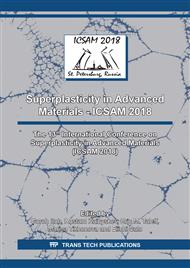p.273
p.278
p.284
p.290
p.296
p.302
p.308
p.314
p.319
Influence of High Pressure Torsion on Thermoelastic and Thermoelectric Response of Pure Copper and Aluminum under Pulsed Laser Radiation
Abstract:
This work presents experimental studying the effect of processing by severe plastic deformation (SPD) on the thermoelastic and thermoelectric properties of pure aluminum and copper under pulsed laser radiation. The studies were carried out on technical aluminum AD1 (99.3%) and pure copper M1 (99.9%). High pressure torsion (HPT) was used for processing by SPD. After the HPT processing, the materials samples in the form of a plane disk were subjected to pulsed laser radiation focused on the disk center. Pulsed lasers with a wavelength of 1.06 micron and operating in the free laser oscillation mode with pulse duration of 100 microseconds or in the mode of a single pulse with duration of about 10 nanoseconds were used. The thermoelastic and thermoelectric responses of the materials were determined by measuring acoustic waves and the thermoelectric power. The disks with the initial coarse-grained material state were considered as a reference sample, and the disks of the materials after SPD processing were considered as a controlled object. The results demonstrated a very high sensitivity of the parameters of thermoelastic and thermoelectric response to structural changes in the materials. For example, the used HPT mode led to a reduction in the maximum thermoelectric power value for aluminum by 40% and for copper by 35%.
Info:
Periodical:
Pages:
296-301
Citation:
Online since:
July 2018
Authors:
Price:
Сopyright:
© 2018 Trans Tech Publications Ltd. All Rights Reserved
Share:
Citation:


